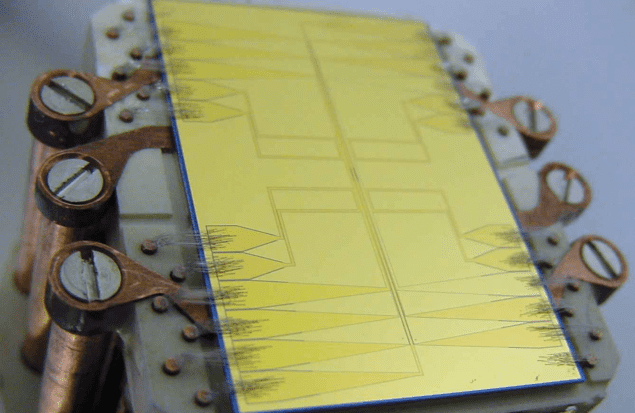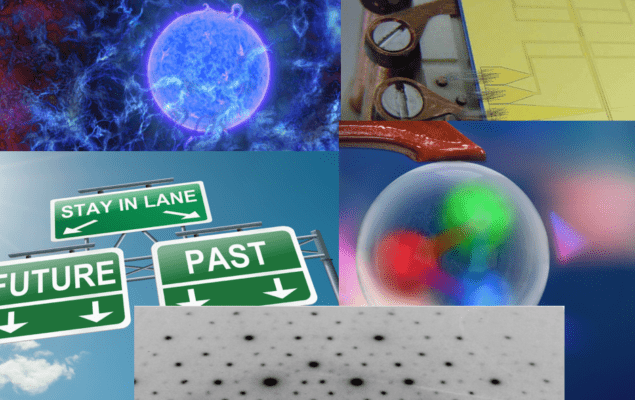2018 Breakthrough of the Year: Hamish Johnston’s shortlist
06 Dec 2018 Hamish Johnston
One of the highlights in the Physics World calendar is the annual announcement of our Breakthrough of the Year, which in recent years has been awarded to such landmark achievements as the first multimessenger observation of a neutron star merger, the detection of gravitational waves by the LIGO scientific collaboration, and the simultaneous quantum teleportation of two fundamental properties of the photon.
So, over the next few days, each of our online editors will select their own top five shortlists from the research they have covered in 2018. Their selections will be based on three criteria:It’s always hard to choose a single winner, and even to pick out the nine other scientific breakthroughs that make it into our Top 10, but this year we realized that we truly have an embarrassment of riches. That’s because three new expert editors have joined the Physics World team to expand our coverage of research fields that benefit from an interdisciplinary approach – medical physics and the biosciences; environment and energy; and materials science and technology – and we wanted to reflect that expanded scope in the 2018 award.
Significant advance in knowledge or understanding
Importance of work for scientific progress and/or development of real-world applications
Of general interest to Physics World readers
After all the shortlists have been published, the editors will huddle together in a locked room to debate and decide which of the breakthroughs will make it into the Top 10 – and which one will be the overall winner. The final announcement of the Physics World 2018 Breakthrough of the Year will be made on Thursday 13 December.
First up are my five picks, which cover core physics topics ranging from cosmology and ultracold atoms through to quantum optics, superconductivity and particle physics.
Ultracold atoms quench a thirst for universality far from equilibrium
Physicists are pretty good at describing matter at or near equilibrium, but nature can be violent, and many important physical processes involve rapid changes far from equilibrium. One way of making sense of far-from-equilibrium processes is to look for universality, whereby very different systems behave in very similar ways. Studying universality far from equilibrium had proven very difficult, but now three independent groups of researchers have done so using ultracold atoms. Universal truth: the atom trap used by Jörg Schmiedmayer and colleagues. (Courtesy: Technical University of Vienna)
Universal truth: the atom trap used by Jörg Schmiedmayer and colleagues. (Courtesy: Technical University of Vienna)
 Universal truth: the atom trap used by Jörg Schmiedmayer and colleagues. (Courtesy: Technical University of Vienna)
Universal truth: the atom trap used by Jörg Schmiedmayer and colleagues. (Courtesy: Technical University of Vienna)
In all three experiments atomic gases were subjected to violent changes. In one experiment, interactions between the atoms were suddenly switched on; in another, a 3D gas was suddenly confined to 1D; and in the third experiment, the spin states of the atoms were suddenly allowed to fluctuate. Thanks to this pioneering work, ultracold atoms could soon be used to simulate a wide range of far-from-equilibrium phenomenon from galaxy formation to colliding nuclei. The work was done by Christoph Eigen, Zoran Hadzibabic and colleagues at the University of Cambridge and University of Colorado; Jörg Schmiedmayer and colleagues at the Technical University of Vienna and the University of Heidelberg; and Maximilian Prüfer and colleagues at the University of Heidelberg.
Quantum mechanics defies causal order, experiment confirms
In classical physics – and everyday life – there is a strict causal relationship between consecutive events. If a second event (B) happens after a first event (A), for example, then B cannot affect the outcome of A. But now, Jacqui Romero, Fabio Costa and colleagues at the University of Queensland in Australia have done an experiment that shows that quantum mechanics can allow events to occur with no definite causal order. They created a “quantum switch”, in which a photon can take two paths. One path involves the photon being subjected to operation A before operation B, while in the other path B occurs before A. If the operations are performed close together in time, then it becomes impossible to tell which was done first. This “indefinite causality” was first predicted in 2012 and the effect – along with team’s quantum switch – could prove useful for processing quantum information. Squeezed state: the internal pressure of the proton has been measured for the first time. (Courtesy: Jefferson Lab)
Squeezed state: the internal pressure of the proton has been measured for the first time. (Courtesy: Jefferson Lab)
 Squeezed state: the internal pressure of the proton has been measured for the first time. (Courtesy: Jefferson Lab)
Squeezed state: the internal pressure of the proton has been measured for the first time. (Courtesy: Jefferson Lab)
Internal pressure of proton is measured for the first time
It is a pressure cooker inside the proton, with crushing forces exceeding those found in a neutron star. That is the conclusion of Volker Burkert and colleagues at Jefferson Lab in Virginia, US who have studied how electrons scatter from protons. They calculated that the quarks inside a proton are subjected to a pressure of about 1035 Pa – about ten times greater than the pressure at the centre of a neutron star — and showed how the pressure varies from the centre to the edge of the particle. As well as providing important information about the strong force, which binds the quarks together, the new technique could lead to a better understanding of the mechanical properties of protons and other hadrons.
Superconductivity spotted in a quasicrystal
Conventional superconductivity arises when pairs of electrons form via an interaction with phonons, which are particle-like deformations that propagate through crystalline lattices. Quasicrystals do not have translational symmetry and therefore do not have crystalline lattices – and should therefore not be conventional superconductors. Since the first quasicrystals were discovered in 1984, some physicists have suggested that superconductivity could occur in quasicrystals and now Keisuke Kamiya and Noriaki Sato at Nagoya University in Japan and colleagues have shown that a metal-alloy quasicrystal is a superconductor a temperatures lower than 0.05 K. Their discovery could lead to the creation of new materials that display fractal superconductivity.
Ancient hydrogen reveals clues to dark matter’s identity
One of the most important unsolved mysteries of physics is the nature of dark matter – the invisible stuff that makes up 26.8% of the total mass and energy in the universe and has a profound effect on the large-scale structure of the universe. Now a potentially huge breakthrough in the study of dark matter has come from an unlikely source: radio emissions detected from hydrogen gas that existed just 180 million years after the Big Bang. Light and dark: did dark matter cool ancient hydrogen?
Light and dark: did dark matter cool ancient hydrogen?
 Light and dark: did dark matter cool ancient hydrogen?
Light and dark: did dark matter cool ancient hydrogen?
Using data from the EDGES all-sky radio antenna in western Australia, a team led by Judd Bowman of Arizona State University have argued that the ancient hydrogen is significantly colder than had been expected. Picking up on their work, Rennan Barkana, of Tel Aviv University, has suggested that dark matter is responsible for the hydrogen’s low temperature. If Barkana is right, this is the first direct observation of a non-gravitational interaction between dark matter and conventional matter and could point to a new way of studying the black stuff.
Check back tomorrow for Anna Demming‘s top 5 breakthroughs in materials science and technology.

15/12/2018 from physicsworld.com

Δεν υπάρχουν σχόλια:
Δημοσίευση σχολίου